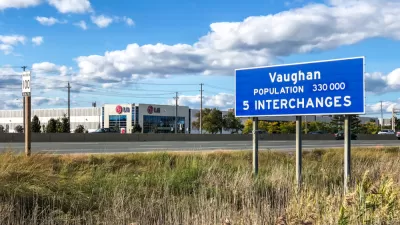Joe Mathews of Zócalo Public Square views with a great deal of skepticism the urban growth boundaries the voters of Ventura County adjacent to Los Angeles County have enacted since 1995 due to the lack of infill. Another measure is on the ballot.

"'No other county in the United States has more effective protections against urban sprawl,' says the website of SOAR, a.k.a. Save Open Space and Agricultural Resources, a family of growth-controlling ballot measures" in Ventura County, writes Mathews in an op-ed for the San Francisco Chronicle.
Those SOAR protections have been fixed in the laws of the county and its cities for two decades. SOAR effectively permits development only within certain urban cores in the county and makes no allowances for population growth. If you want to develop protected open space or change the development boundaries, you need a vote of the people.
Smart growth strategies like SOAR are not only supposed to preserve open space. They also are supposed to drive more creative, dense, multifamily and transit-oriented development in the urban cores where growth is still permitted.
In addition to being a series of ballot initiatives, the website states that SOAR is also "a non-profit grassroots group of citizens in Ventura County, California who are dedicated to keeping Ventura County from following the same urban sprawl pattern that has plagued the rest of Southern California."
But what happens when infill doesn't accompany the urban growth boundaries that guard against unfettered development? Mathews writes that SOAR has "opposed multifamily and denser developments, and resisted transit investments to connect their cities." Consequently, residents "have enjoyed the benefits of being antigrowth — while avoiding the related responsibilities."
Mathews borrows from one of Donald Trump's famous campaign themes on immigration:
Those sprawling suburban housing developments that fill the San Fernando Valley to the east? They stop at the county’s edge. It’s almost as if Ventura County has built a wall against growth along its border — and made neighboring Los Angeles pay for it.
The results are as obvious as the choking traffic on the 101 freeway and housing prices that make Ventura County one of the country’s least affordable places. The lack of housing for middle- and lower-income people forces them to commute from outside the county, and it makes it hard for companies to grow and locate there.
Certainly Ventura County is not alone is resisting infill. Voters need not approve urban growth boundaries to fight new development, but it does give them an effective tool to stop development without accompanying incentives to promote development within the UGB boundaries.
But in its resistance to infill development, Ventura is an example of the California disease — grab your piece of the Kingdom, and keep out anyone who might come after you.
SOAR's lesson to California:
[G]rowth boundaries like SOAR shouldn’t be pursued in isolation. They need to be tied to rock-solid requirements for creating more housing in urban cores, both for low-income and middle-income people.
November ballot measures
Voters will decide on two competing measures on Nov. 8. SOAR, which backs Measure C, claims that Measure F "will allow the conversion of thousands of acres of open space and agricultural land into urban development."
According to a county document [PDF] listing local ballot measures, both measures center on agricultural, not urban development.
County of Ventura Measure “C” [italics added]
“Shall the current ordinance requiring a vote of the people for changes to Open Space, Agricultural and Rural General Plan
land use designations, goals and policies in the unincorporated area of the County be extended from 2020 through 2050,
with specified modifications, such as permitting changes without a vote to allow for up to 12 acres of land to be used for
food processing?”
County of Ventura Measure “F” [italics added]
“Shall the current ordinance requiring a vote of the people for changes to Open Space, Agricultural and Rural General Plan
land use designations, goals and policies in the unincorporated area of the County be extended from 2020 through 2036,
with specified modifications, such as permitting changes without a vote to allow for redesignation of land adjacent to certain
school sites and up to 225 acres of land to be used for food processing?”
According to a local media report, Measure F would allow farmers to use their land for non-agricultural purposes after 2036, while Measure C continues the SOAR protections to 2050.
Other posts on Mathews pieces:
- Demographic Changes and Environmental Leadership in Sacramento, September 4, 2016
FULL STORY: Prevent sprawl but require denser development

Trump Administration Could Effectively End Housing Voucher Program
Federal officials are eyeing major cuts to the Section 8 program that helps millions of low-income households pay rent.

Planetizen Federal Action Tracker
A weekly monitor of how Trump’s orders and actions are impacting planners and planning in America.

Ken Jennings Launches Transit Web Series
The Jeopardy champ wants you to ride public transit.

Washington Legislature Passes Rent Increase Cap
A bill that caps rent increases at 7 percent plus inflation is headed to the governor’s desk.

From Planning to Action: How LA County Is Rethinking Climate Resilience
Chief Sustainability Officer Rita Kampalath outlines the County’s shift from planning to implementation in its climate resilience efforts, emphasizing cross-departmental coordination, updated recovery strategies, and the need for flexible funding.

New Mexico Aging Department Commits to Helping Seniors Age ‘In Place’ and ‘Autonomously’ in New Draft Plan
As New Mexico’s population of seniors continues to grow, the state’s aging department is proposing expanded initiatives to help seniors maintain their autonomy while also supporting family caregivers.
Urban Design for Planners 1: Software Tools
This six-course series explores essential urban design concepts using open source software and equips planners with the tools they need to participate fully in the urban design process.
Planning for Universal Design
Learn the tools for implementing Universal Design in planning regulations.
Heyer Gruel & Associates PA
Ada County Highway District
Institute for Housing and Urban Development Studies (IHS)
City of Grandview
Harvard GSD Executive Education
Toledo-Lucas County Plan Commissions
Salt Lake City
NYU Wagner Graduate School of Public Service




























